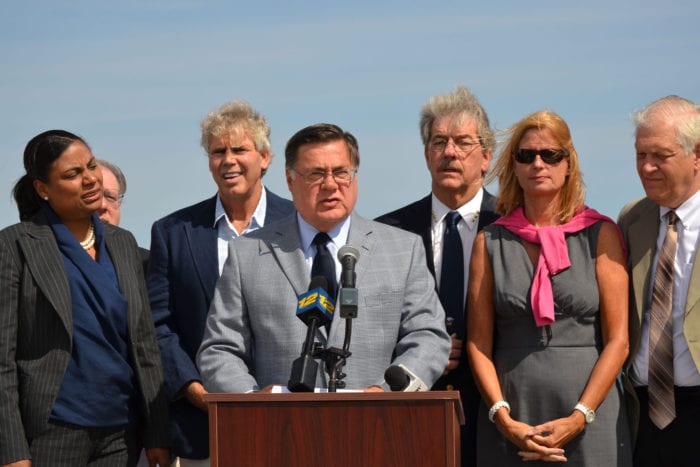A neglected, pre-Revolutionary War house on the corner of New York Avenue and Main Street in Smithtown and other historically significant structures in the area could help boost the town’s future, according to a Smithtown historian.
Smithtown scholar Corey Victoria Geske urged for Supervisor Patrick Vecchio (R) and town council members to draft a resolution to start a Town Hall National Register Historic District in the downtown area at the Aug. 8 town board meeting, which, according to her, would serve to benefit the region’s economy.
She asked the resolution be expedited by the Town Planning Department in cooperation with the Society for the Preservation of Long Island Antiquities as well as the community.
The proposed historic district, which Geske first proposed to the board about eight months ago, would center on the town hall building — built in 1912 by St. James architect Lawrence Smith Butler — and include the 106-year-old Trinity AME Church on New York Avenue, the 105-year-old Byzantine Catholic Church of the Resurrection on Juniper Avenue and the 265-year-old Arthur House.

The Arthur House is the only Revolutionary War-era house on the Route 25A Spy Trail, Geske said, and currently sits on the grounds of the Smithtown Central School District. It’s a property she has pushed in the past to be included on the National Register of Historic Places.
Geske informed the board that the house, built in 1752, was once inhabited by Mary Woodhull Arthur, the daughter of Abraham Woodhull — better known as Samuel Culper Sr. — George Washington’s chief operative during the famous spy ring. The intelligence he provided helped win the American Revolution.
Her recent call for the historic district coincided with the July 27 bipartisan legislation introduced by Congressman Tom Suozzi (D-Glen Cove) and Rep. Lee Zeldin (R-Shirley) designating the Washington Spy Ring National Historic Trail. The trail runs through towns and villages in both Nassau and Suffolk counties, including Smithtown along Route 25A.
“Let Smithtown lead the way in a big way by capitalizing on its own special history and world-class architecture added to the heritage now being recognized at the state and national levels for all towns along the Route 25A Washington Spy Trail from Great Neck to Port Jefferson,” Geske said at the board meeting. “The Washington Spy Trail wouldn’t exist if not for the father of Mary Woodhull Arthur of Smithtown, a true daughter of the American Revolution.”
She also noted The Ward Melville Heritage Organization and North Shore Promotion Alliance were granted funds from the state to install signs along the trail in May.

Geske said registering the Arthur House would be beneficial to the town as it could bring about possible grants from the state for the restoration and stabilization of old properties and promote more tourism in that area.
“The Arthur House was on the SPLIA’s endangered list over 10 years ago and it’s a building that’s been proposed for demolition,” she said. “These are the buildings that have been cast off in the past. [But] they actually could become the cornerstone for revitalizing downtown Smithtown. The history can actually bring to life a new future for downtown, it would be amazing.”
Sarah Kautz, director of preservation for SPLIA, said she hopes the town will involve its vast history into the downtown revitalization efforts. The town’s comprehensive revitalization plans came to the conclusion its historic buildings were an important component, according to Kautz, but did not provide concrete plans to address them.
“The town has never really incorporated preservation in a systematic way that would bring it into the wider plan for revitalization,” Kautz said. “The Arthur House is important because it’s an early property and is part of Smithtown’s really interesting early history going back into the 18th century. We would love to see a real clear approach for how those historic properties are going to fit into the revitalization and there’s a great potential for them to do so.”
The town board is in the process of evaluating Geske’s proposal, according to Councilman Tom McCarthy (R).
“We’ve asked the planning department to see how feasible it is … we’ll have to look at the pluses and minuses, do due diligence, but it could be a benefit to the township as a whole,” McCarthy said. “We have so much history [and] it’s very important to preserve it but now we have to look at everything surrounding it. We don’t want to shoot from the hip.”
































